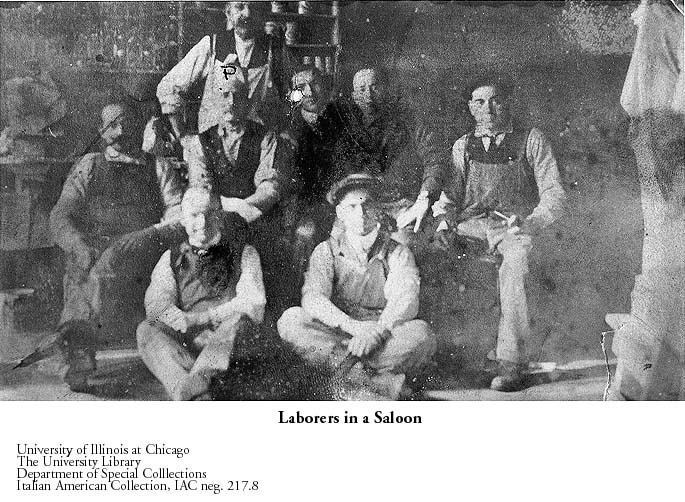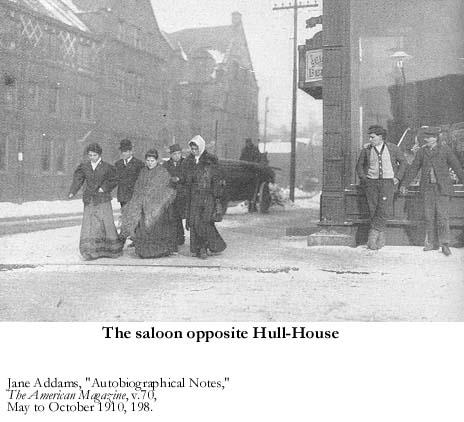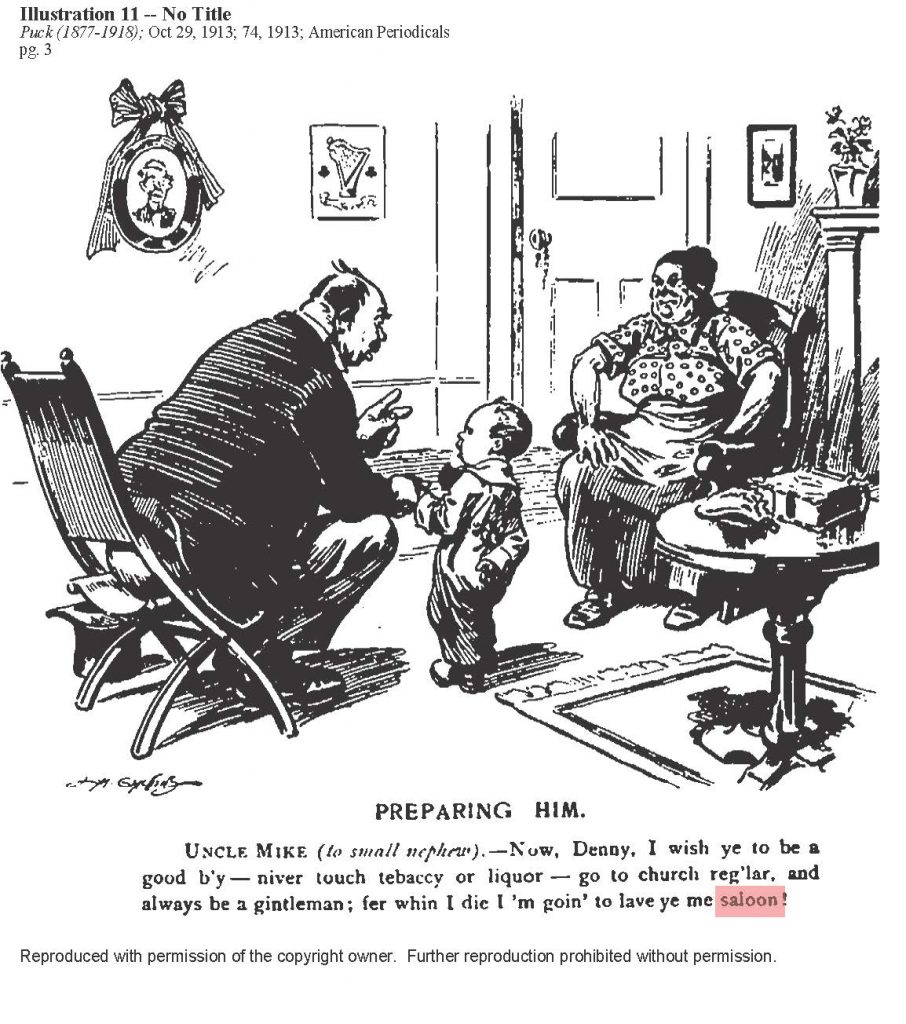CONTENT
- HOME PAGE
- PROLOGUE AN URBAN LEGACY
- INTRODUCING THE WEST SIDE
- 19th-CENTURY CAMERA
- URBAN PHOTOGRAPHERS HINE AND KIRKLAND
- PICTORIAL CHICAGO
- CHICAGO ENLIGHTENED CITY BEAUTIFUL
- CHICAGO GROTESQUE LAWLESS STREETS
- HULL-HOUSE "OASIS" IN A SLUM
- IMMIGRANT EMIGRANT CITY
- "ALIEN" COLONIES
- "RACE" COLONIES
- GHETTO LIVING
- "CHEAP" ECONOMY
- FAMILY
- AMUSEMENTS
- PUBLIC HEALTH
- TENEMENTS
- URBAN SOCIOLOGY CHICAGO SCHOOL
- MAXWELL STREET ARCHITECTURE TOUR
- CHICAGO CITY MAPS
SALOON
Saloons proliferated on West Side streets. Pictured above (center) were unemployed men on a weekday morning in front of the saloon immediately across Halsted Street from Hull-House. In 1909 the impact of the financial panic of 1907 was still being seen on Chicago streets. What was the saloon? Was it a poor man’s social and political club for male conviviality and relaxation or was it a social and moral evil on the slippery slope downward to destitution, the poor house and destruction?
Saloons were big business in Chicago, and a central meeting place for ethnic politicians. Male working-class immigrants from diverse nationalities but especially Irish were culturally hostile, even contemptuous, of the largely female Anglo middle-class temperance reformers. Teetotalers prided themselves on an historical legacy crusading against the consequences of personal enslavement to carnal lascivious appetites.
“Rushing the Growler” was a phrase that became popular in the 1890s. The growler was a bucket, pitcher, or can carried by children to the tavern for “suds” and returned during the day to the father’s workplace usually at lunchtime. The name growler came from the grating sound as the bucket slid across the bar. bjb

INTRODUCTION
- Saloon ‘Poor Man’s Club’: Chicago’s West Side by Steven A. Brown
- Ethnic Saloon On Near-West-Side Streets by Jeff Sichz
PHOTO GALLERY
SOCIAL VALUE OF THE SALOON (1893-1908)
- The Saloon as a Club by Thomas Gilmore Madore (1893)
- The Saloon and The Sabbath by Ferdinand C. Iglehart (1895)
- The Social Value Of The Saloon by E.C. Moore (1897)
- The Saloon In Chicago by Royal L. Melendy (1900)
- The Saloon In Chicago II by Royal L. Melendy (1901)
- The Boy and The Saloon-Keeper (1906)
- The Saloon Problem by Hugh F. Fox (1908)
- The Work of The Anti-Saloon League by J.C. Jackson (1908)
LOCAL WITNESSES TESTIFY
- American Hobo by Nels Anderson
- Graveyard Of Shattered Hopes by Elias Tobenkin
- Saloon Has Strong Rival by Elias Tobenkin
- Women through the Side Door by a Jewish Immigrant Girl
- The Mission Mill by Nels Anderson
- Rushing-the-Can by an Italian Immigrant Woman
- Cub Reporter by Theodore Dreiser
POOR WOMAN’S, POOR MAN’S CLUB (1899-1915)
- Saloon View of the Poor Man’s Club (1899)
- Indorse Saloon as a ‘Necessity’ (1907)
- West-Side Bars Defy New Order, Saloons Filled With Women and Music after 1 A.M. (1907)
- West Side Levee Must Be Orderly or Licenses Revoked, Many Saloons Cater To Women (1908)
- Vigor Increases, ‘Wets’ and ‘Drys’ Display Increased Energy in Contest for Victory (1910)
- West Side Levee Saloons Defy Order, Unescorted Women Going Into Place (1911)
- Saloon of City Club for Poor Or Hades Gate (1915)
REFORMERS, SOCIAL EVIL IN CHICAGO (1908-1913)
- Drinking Women Nation’s Menace, Puts Blame on Mothers (1908)
- 100 Saloons Hold Wineroom Vice, Women in Forbidden Booths, Law is Violated Openly (1910)
- Red Light List Sent to Mayor by Committee of 15, City’s Social Evil (1913)
- Survey of Conditions Demoralizing to Women and Girls in the Saloons in Chicago (1911)
- The Social Evil and The Saloon in Chicago (1911)
- See Slumming Club Women and Reformers
REFORMERS, SUBSTITUTES FOR THE SALOON (1901-1910)
- Substitutes For The Saloon by Raymond Calkins (1901 and 1919)
- Five Cent Shows Favored by Club Women, Keep Men Out of Saloon and Dispel Blues (1907)
- The Spirit Of Youth by Jane Addams (1909)
- Vegetable Diet Saloon’s Knell? Fruit Foe of Highball (1910)
- See Picture Show Substitute for the Saloon: Promiscuous Amusement
SALOON (1878-1913): POPULAR CARTOONS
- Sunday Medicine Law (1878)
- A Sketch From Life (1883)
- What The Country Needs At Present (1884)
- Brotherhood Of Art (1885)
- An Explanation (1886)
- Great Double-Faced Campaign (1886)
- Civilization (1888)
- An Attempt At Rescue (1889)
- Day In the Life of a Superstitious Man (1889)
- Ugly Duckling or the Prophecy that Failed and the Fad that Flourished (1896)
- Another Hatchet Story (1901)
- How To Do Away with the Use of Money In Elections (1906)
- Lots For Sale (1909)
- Preparing Him (1913)








